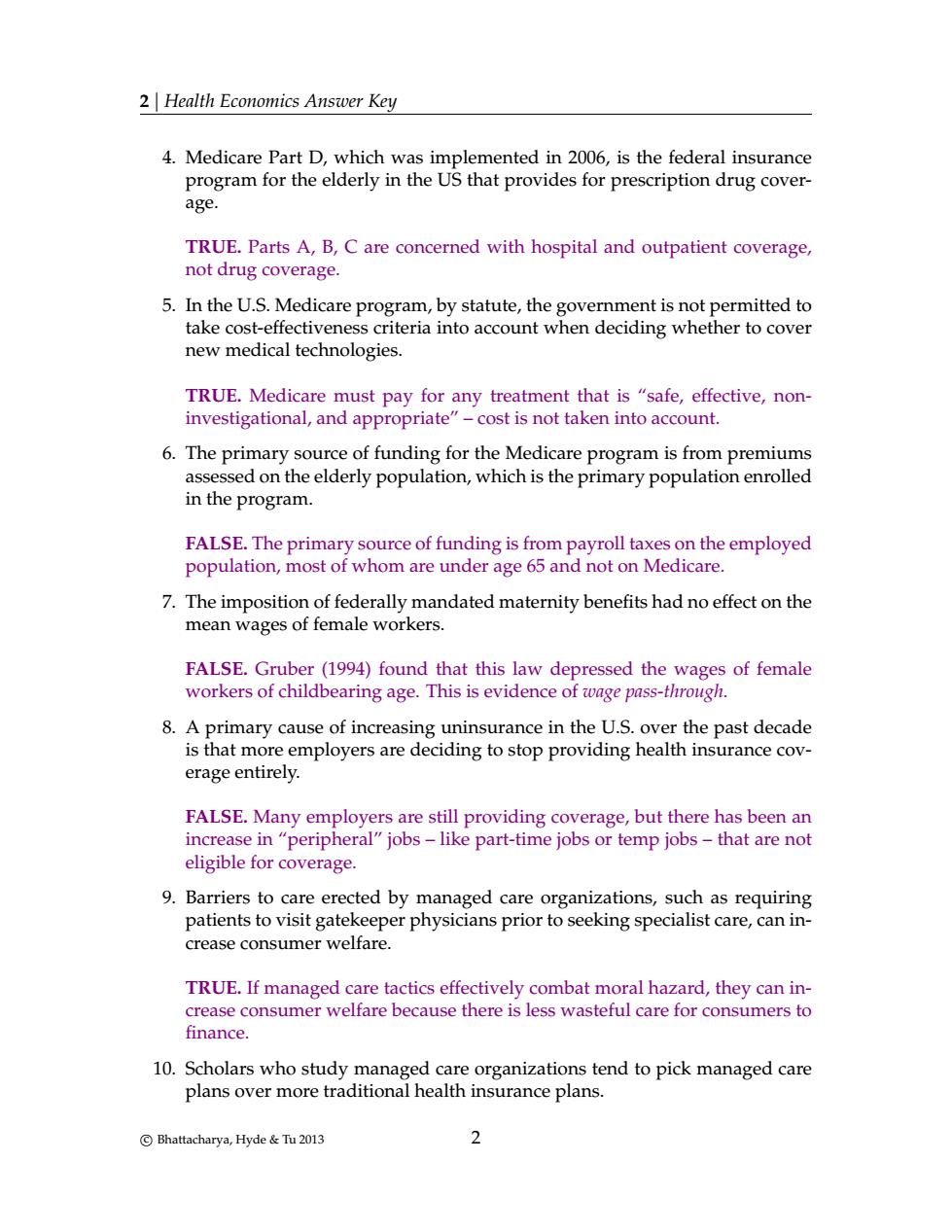正在加载图片...

2 Health Economics Answer Key 4.Medicare Part D,which was implemented in 2006,is the federal insurance em for the elderly in the US that provides for prescription drug TRUE.Parts A,B,C are concerned with hospital and outpatient coverage, not drug coverage. 5.In the U.S.Medicare prog take e cost-effe teria into account deciding whether to cove new medical technologies. TRUE.Medicare must pay for any treatment that is "safe,effective,non- investigational,and appropriate"-cost is not taken into account. 6.The primary source of funding for the Medicare program is from premium assessed on the elderly population,which is the primary population enrolled in the program. FALSE.The primary source of funding is from payroll taxes on the employed population,most of whom are under age 65 and not on Medicare. 7.The imposition of federally mandated maternity benefits had no effect on the mean wages of female workers. FALSE.Gruber (1994)found that this law depressed the wages of female workers of childbearing age.This is evidence of wage pass-through. 8.A primary cause of inreasing uninsurance in the U.Sover the past decade is that more employers are deciding to stop providing health insurance cov- erage entirely. FALSE.Many employers are still providing coverage,but there has been an increase in" peripheral"jobs-like part-time e jobs eligb for coverage. temp jobs-that are not 9.Barriers to care erected by managed care organizations,such as requiring patients to visit gatekeeper physicians prior to seeking specialist care,can in- crease consumer welfare TRUE.If managed care tactics effectively combat moral hazard,they can in crease consumer welfare because there is less wasteful care for consumers to finance. 10.Scholars who study managed care organizations tend to pick managed care plans over more traditio nal health insurance plans. Bhattacharya,Hyde &Tu 2013 22 | Health Economics Answer Key 4. Medicare Part D, which was implemented in 2006, is the federal insurance program for the elderly in the US that provides for prescription drug coverage. TRUE. Parts A, B, C are concerned with hospital and outpatient coverage, not drug coverage. 5. In the U.S. Medicare program, by statute, the government is not permitted to take cost-effectiveness criteria into account when deciding whether to cover new medical technologies. TRUE. Medicare must pay for any treatment that is “safe, effective, noninvestigational, and appropriate” – cost is not taken into account. 6. The primary source of funding for the Medicare program is from premiums assessed on the elderly population, which is the primary population enrolled in the program. FALSE. The primary source of funding is from payroll taxes on the employed population, most of whom are under age 65 and not on Medicare. 7. The imposition of federally mandated maternity benefits had no effect on the mean wages of female workers. FALSE. Gruber (1994) found that this law depressed the wages of female workers of childbearing age. This is evidence of wage pass-through. 8. A primary cause of increasing uninsurance in the U.S. over the past decade is that more employers are deciding to stop providing health insurance coverage entirely. FALSE. Many employers are still providing coverage, but there has been an increase in “peripheral” jobs – like part-time jobs or temp jobs – that are not eligible for coverage. 9. Barriers to care erected by managed care organizations, such as requiring patients to visit gatekeeper physicians prior to seeking specialist care, can increase consumer welfare. TRUE. If managed care tactics effectively combat moral hazard, they can increase consumer welfare because there is less wasteful care for consumers to finance. 10. Scholars who study managed care organizations tend to pick managed care plans over more traditional health insurance plans. c Bhattacharya, Hyde & Tu 2013 2